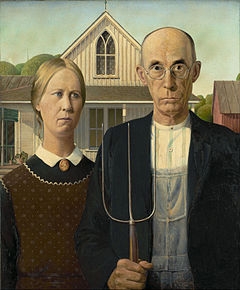
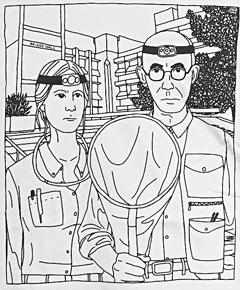
When the 105th annual UC Davis Picnic Day takes place Saturday, April 13, thousands of visitors will explore the campus. It promises to be informative, educational and entertaining.
But over at Briggs Hall, home of the UC Davis Department of Entomology and Nermatology, “special guests” will include bugs.
There will not only be cockroach races, maggot art, and displays of bees, ants, aquatic insects—and more!—but huge images of vectors, the incredible macro photography of medical entomologist/geneticist Geoffrey Attardo, assistant professor, UC Davis Department of Entomology and Nematology.
Virtual Reality Bugs
Attardo will be demonstrating “Virtual Reality Bugs” where youths and adults can watch 40-foot tall, three-dimensional insects and spiders. And in his medical entomology display, he will be exhibiting metal prints of vectors, including a tsetse fly, kissing bug, deer tick, mosquito, stable fly, cat flea and bed bug.
You wouldn't want to encounter a bed bug in your bed, or a flea or tick on your dog, or a mosquito on your arm. You may not even know what they look like up close. But with these images, you can see what's bugging you or your pets.
And with the Virtual Reality Bugs, participants can select what they want to see--or what's towering over them. The list includes a black widow spider, ant, beetle, grasshopper, damsel fly, cicada, cockroach, and a tsetse fly. Each person will be limited to about 30 seconds to accommodate the crowd.
The Briggs Hall activities run from 9 a.m. to about 4:30, while activities at the Bohart Museum of Entomology, will be offered from 11 a.m. to 2 p.m.
TheBohart Museum will focus on the theme, "Will Travel for Bugs: TheBohart Museum of Entomology's Collections from Around the World." It's nominated for a people's choice award, as is the honey tasting exhibit at Briggs Hall. Participants will sample meadowfoam, sage, cotton and buckwheat. QR codes will be at each site. (See news story about the activities at both sites.)
Vectors
But back to the vectors. Did you know that the Bohart Museum provides information or fact sheets on its website at http://bohart.ucdavis.edu/insect-info-sheets.html?
You can learn about some of the vectors that will dwarf you when you visit Briggs Hall.
For example, ticks!
"Ticks are blood-feeding external parasites of mammals, birds, and reptiles throughout the world," writes Lynn Kimsey, director of the Bohart Museum and UC Davis professor of entomology. "They are not insects rather they are arachnids, the same group that includes spiders and scorpions. There are two different groups of ticks, the hard ticks (Ixodidae) and soft ticks (Argasidae). Both are important vectors of pathogens to humans and animals throughout the world. Some diseases of current interest in the United States caused by tick-borne pathogens include Lyme Disease, Rocky Mountain Spotted Fever, and tick-borne Relapsing Fever (soft ticks)
"Many ticks seek hosts by 'questing.' Questing ticks crawl up the stems of grass or perch on the edges of leaves in a typical posture with the front legs extended. Certain chemicals, such as CO2, as well as heat and movement cause questing behavior. Ticks climb onto a potential host that brushes against their extended front legs. Once on a host hard ticks may feed for several days to several weeks.
And fleas!
"Fleas are bloodsucking parasites of humans, livestock and pets," Kimsey writes. "Only adult fleas feed on blood, which they obtain with their piercing/sucking mouthparts. Adult fleas blood feed on birds and mammals.Adult fleas are laterally flattened, wingless insects. They have a small eye spot on the side of the head, and a row of stout spines along the side of the head and the back of the thorax. Adult fleas travel rapidly by jumping, using their legs and a spring-like mechanism in the body. They are capable of spectacular leaps, covering distances up to one hundred times their body length
"The most common flea found on household pets, such as cats and dogs, is the cat flea, Xenopsylla cheopis."
Read the Bohart fact sheets and then check out Attardo's images.
EGSA T-Shirts
If you'd rather wear your bug on your shirt, the Entomology Graduate Student Association (EGSA) can oblige. They have scores of insect-themed t-shirts, ranging from beetles and honey bees to wanna bees. The newest t-shirts in the line-up include two designed by talented doctoral student/ant specialist Jill Oberski of the Phil Ward lab. One is a take-off of American Gothic, the 1930 painting by Grant Wood, except with entomologists holding a net in front of Briggs Hall, UC Davis campus, instead of the farmers holding a pitchfork in front of their farmhouse. The other Oberski t-shirt celebrates the 45th anniversary of UC Davis Picnic Day cockroach races. Roaches rock! Forensic entomologist Robert Kimsey, co-chair of the department's displays at Picnic Day, rears cockroaches in his lab, but on Picnic Day, they're ready to race! Doctoral candidate Brendon Boudinot, EGSA president and co-chair of the department's displays, says the roaches will race on a new racetrack.
Doctoral student/nematologist Corwin Parker of the lab of Steve Nadler, professor and chair of the UC Davis Department of Entomology and Nematology, also came up with a clever idea for a t-shirt. You know how cicadas can be REALLY loud? He drew one plugged into an amp. Now, that's REALLY loud! You can buy EGSA t-shirts at Briggs Hall on Picnic Day or order them online at https://mkt.com/UCDavisEntGrad/ after Picnic Day.
Attached Images:
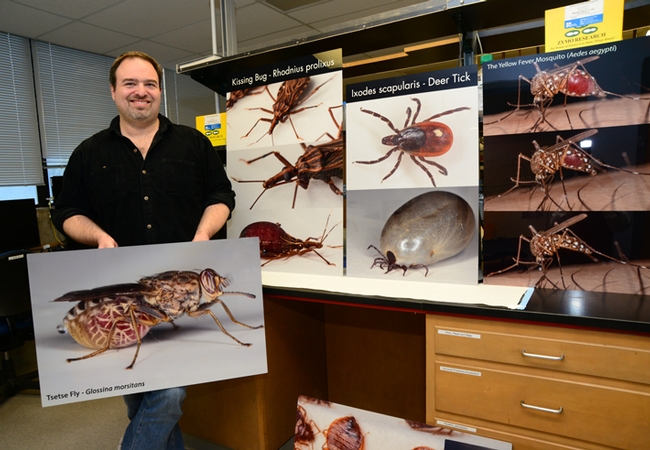
UC Davis medical entomologist Geoffrey Attardo holds one of his images, a tsete fly. He does research on the fly. He also will be showcasing his other images of vectors on UC Davis Picnic Day. (Photo by Kathy Keatley Garvey)
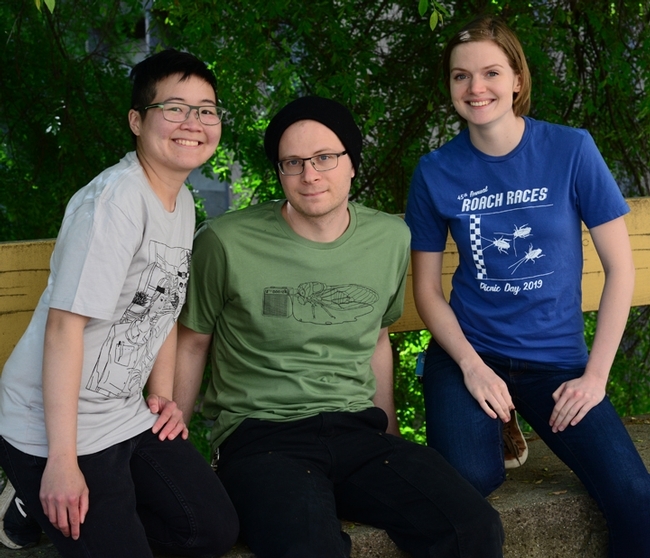
These are the new t-shirts to be offered by the Entomology Graduate Student Association on UC Davis Picnic Day. From left are artists/scientists Ivana Li, Corwin Parker and Jill Oberski. (Photo by Kathy Keatley Garvey)
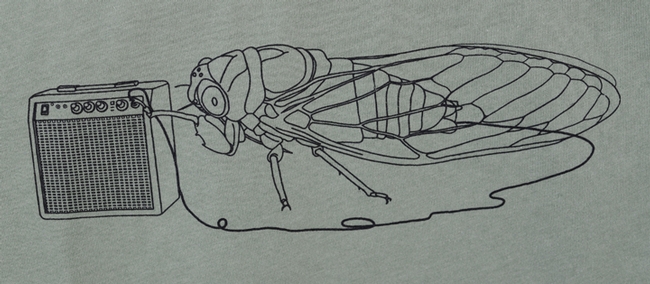
You know how loud cicadas are? Well, doctoral student/nematologist Corwin Parker drew this prize-winning sketch for a EGSA t-shirt: a cicada plugged into an amp.